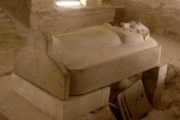Viewings: 8713

Experts restore the largest ancient Egyptian sarcophagus of red granite, which rested the mummy of Pharaoh Merneptah, son and successor of Ramses II. Striking not only the external dimensions of the sarcophagus, but that sarcophagi - four, one inside the other. But the images should tell scientists what purpose it was done.
Thirteenth son of Pharaoh Ramses II 19th dynasty Merneptah rules about ten years: 1212 on 1202 years B.C. Or on the Dating of modern German Egyptologist Thomas Schneider (Thomas Schneider): 1213-1204 years B.C. by the time of the death of Ramses II, who for so long ruled the country, his elder sons had already passed away. The throne passed to Merneptah were far from young years, when on the Northern border with Syria were riots, and the tribes in West Asia rose against the Egyptian colonists.
In 1886, a prominent British archaeologist sir William Matthew Flinders Petrie (Sir William Matthew Flinders Petrie) amounted to plan and described the ruins of the temple of Merneptah. According to the scientist, it was almost entirely built of stones, borrowed from a nearby temple of Amenhotep III. However, Merneptah broke the temple predecessor, which had already begun to deteriorate during the severe floods. It only remains to transport stone blocks and statues to his temple. Actually, his father, Ramesses II, was doing the same thing with more ancient sanctuaries.
On the wall behind the sixth pylon in Carnac and on the large stele, known as "Stella of Israel", - as it was first seen mention of Israel in Egyptian texts - Merneptah ordered to carve the text in prose and verse, which enumerates the territory and settlements fell under the power of Egypt. From here it is known that his army ruthlessly with the rebels in Syria and even conquered Palestine. Managed to repel the invasion of the so-called "peoples of the sea". On the fifth year of the reign of Merneptah in a bloody battle defeated the Libyans. For his successful military campaigns Merneptah was named "victorious", "worthy of gods".
Previously Egyptologists have assumed that Merneptah was "the Pharaoh of the Exodus", drowned in the Red sea. However, it severely damaged parts of the mummy tomb with 12 other found in the Valley of tsars in tomb of Amenhotep II. In all likelihood, the priests put him in a mummy in four stone box, put one into another. Currently reconstructed external of them have a length of 4 meters, a width of 2.3 metres and a height of 2.5 metres. The sarcophagus was brightly painted and had a cover that remained intact. Specialists embalming assert that the Pharaoh Merneptah suffered from toothache, suffered from arthritis and atherosclerosis, and fractures of the hip.
"As far as I know, - said in an interview to LiveScience, the head of works on reconstruction Edwin Brock (Edwin Brock)is the biggest of all the king's sarcophagus". Research fellow of the canadian Royal Ontario Museum assumes that the sarcophagi were in the tomb already nested into each other. Holes in the input shaft testify that was applied pulley blocks and pulleys, which sarcophagi lowered into the tomb. When the workers came to the burial chamber, they found that the sarcophagi in the door not pass. Had to destroy the doorway, and then again to close up. "This study revealed several interesting aspects of life in ancient Egypt, which makes them look less godlike", says Edwin Brock.
To the study of fragments from the tombs of Merneptah began in the 1980-ies. Then they were lying in the burial chamber disorderly pile. When they were able to gather together, there was only one third of the sarcophagus. To its full-scale reconstruction began in March last year.
Striking not only the external dimensions of the sarcophagus, unusual that four of them. Behind the outer box is the second granite sarcophagus with an oval cover with cartouche, framing the name of Merneptah. The third coffin was removed even during the reign of Pharaoh 21st dynasty Psusennesa I (rules about 1040-994 years BC).
In the fourth, made of travertine (a limy tufa), was the mummy. From last only a few fragments, and the mummy was reburied after more than three thousand years ago in the tomb penetrated the plunderers. The first two boxes broke to get to the third, which was intended for Psusennesa I. Traces of fire and hacking, according to Brock, saying that granite is first heated up, and then quickly cooled water to give it fragility.
Egyptologists unable to answer the question, why Merneptah would such a great sarcophagus. Some of the kings, too, were buried in several sarcophagi, but none of them had such a large external. Brock recalls that the father of Merneptah Ramses II and the grandfather of SETI I (both are great builders), each of which was buried in the same sarcophagus of travertine. Find a hint of a clue will try through the image on the sarcophagi of Merneptah. They depict two texts.
Requiem text "Books gates" narrates about the transition of the soul of the deceased to the other world, like the journey of the sun, going to the other world at night. The book "Amduat" also refers to the funeral texts inscribed on the walls taranovyh tombs. Both literary works consists of 12 chapters, or "hours".
Edwin Brock notes that the same watch shows on boxes and covers sarcophagi of Merneptah. One motive of the first scenes "Books Gates", including the image of the region, which existed before the Sun God entered into the afterlife, the king seems particularly liked. According to the viewpoint of the largest contemporary connoisseur of the Egyptian theology, German scientist Eric Hornung (Erik Hornung), after the entry of the Sun God in the realm of the underworld, it welcomes't separate God and the dead, which outlined "gods of the West". For Merneptah these repeated scenes are possible provided the resurrection of the dead.
















